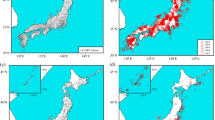Abstract
The natural disaster risk assessment model based on support vector machine (SVM) is put forward according to the features of natural disaster risk assessment. The indicator system which includes the collapse of houses, the affected areas, the number of casualties, direct economic losses is established by China’s actual situation of the regional meteorological disaster. A case for assessing the natural disasters risk of Chinese regions is studied using the established model. The evaluation results show that the evaluation model established is simple and effective. It has good generalization ability in the case of small samples. The results of research in this paper have important reference for natural disaster risk management and decision-making.
Preview
Unable to display preview. Download preview PDF.
Similar content being viewed by others
References
Zhang, L., Zhang, Y.C., Luo, Y.H.: Disaster Assessment of Geological Disasters in the Theory and Practice. Geological Publishing House, Beijing (1998)
Chang, S.E., Shinozuka, M.: Measuring ImProvements in the Disaster Resilience of Communities. Eartliquake Spectra 20(3), 739–755 (2004)
Chang, S.E., Chamberiin, C.: Assessing the Role of Lifeline Systems in Community Disaster Resilience, pp. 87–94. MCEER Publications, New York (2004)
Mitchem, J.D.: Place vulnerability to Tornadoes in the United States: A Multi-scale Assessment. University of South, Carolina (2004)
Huang, C.F., Shi, P.J.: Two-level Model of Risk Assessment of Natural Disaster on City. Journal of Catastrophology 3(2), 22–27 (1994)
Wang, R.Z., Wang, Z.X.: Research on Regional Natural Disasters Division Based on Fuzzy Clustering Analysis: A Case Study in Sichuan Province. Journal of Disaster Science 8(1), 6–12 (1993)
Feng, P., Zhang, B.: Assessment of Magnitude of Drought Based on Artificial Neural Network Method. Systems Engineering Theory and Practice 20(3), 141–144 (2000)
Xu, H.L., Chen, Y.N.: Flood Hazard Classification Based on Fuzzy Cluster Analysis. Journal of dry Geographical Area 23(4), 350–352 (2000)
Huang, T.Z.: Flood Disaster Losses Rapid Assessment Based on BP Neural Network. Journal of Hohai University 31(4), 457–460 (2003)
Liu, W.D., Yin, H.B., Cheng, C.L.: Strong Winds and Heavy Rain Disaster Loss Assessment Based on Grey Correlation Degree Method. Meteorological Science and Technology 54(4), 563–566 (2007)
Wang, F., Yin, Z.N.: Natural Disasters Dynamic Risk Assessment Model Based on Multi-agent. Geography and Geo-Information Science 25(2), 85–88 (2009)
Dai, B.Y., Li, Z.Q., Li, X.L.: A Method of Classing Natural Disaster Loss Based on Matter-element Theory. Journal of Catastrophology 24(1), 1–5 (2009)
Vapnik, V.: Statistical Learning Theory. Wiley, New York (1998)
Chi-wei, H., Chih-jen, L.: A Comparison of Methods for Multiclass Support Vector Machine. IEEE Transacatutions on Neural Networks 13(2), 415–425 (2002)
Gold, C., Sollich, P.: Model Selection for Support Vector Machine Classification. Neurocomputing 55, 221–249 (2003)
Smola, A.J., Sehölkopf, B.: A Tutorial on Support Vector Regression. Statistics and Computing 14, 199–222 (2004)
Deng, N.Y.: New Data Mining Method: Support Vector Machine. Science Press, Beijing (2004)
Xiao, J.H., Wu, J.P., Yang, S.Z.: Research on Comprehensive Evaluation Method Based on Support Vector Machine. Journal of Computer Engineering 28(8), 28–30 (2002)
LIBSVM—A Library for Support Vector Machines (2005), http://www.kernel-machines.org
Li, Z.Y., Deng, X.M.: Natural Disasters Evaluation Based on Matter Element Analysis Model. Journal of Natural Disasters 3(2), 28–33 (1994)
Author information
Authors and Affiliations
Editor information
Editors and Affiliations
Rights and permissions
Copyright information
© 2009 Springer-Verlag Berlin Heidelberg
About this paper
Cite this paper
Chen, J., Zhao, S., Liao, W., Weng, Y. (2009). Research on Natural Disaster Risk Assessment Model Based on Support Vector Machine and Its Application. In: Leung, C.S., Lee, M., Chan, J.H. (eds) Neural Information Processing. ICONIP 2009. Lecture Notes in Computer Science, vol 5864. Springer, Berlin, Heidelberg. https://doi.org/10.1007/978-3-642-10684-2_85
Download citation
DOI: https://doi.org/10.1007/978-3-642-10684-2_85
Publisher Name: Springer, Berlin, Heidelberg
Print ISBN: 978-3-642-10682-8
Online ISBN: 978-3-642-10684-2
eBook Packages: Computer ScienceComputer Science (R0)




